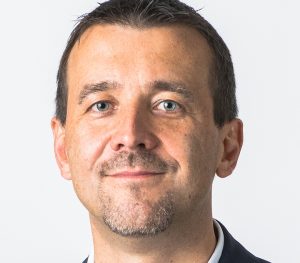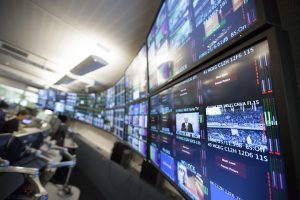SVG Europe Sit-Down: Eurovision Media Services’ Franck Choquard on forthcoming events and new technologies

Franck Choquard, Head of Products & Marketing, Eurovision Media Services
Eurovision Media Services (EMS), the business arm of the European Broadcasting Union (EBU), provides services for sports federations and media organisations around the world, producing and delivering premium live events on all platforms. The Eurovision Global Network uniquely combines satellite and fibre in a dedicated, fully-managed environment, complimented by internet and mobile networks. Our discussion with Franck Choquard, Head of Products & Marketing, began with reflections on 2017…
Can you look back on 2017 and discuss some of the highlights of the EMS year?
Looking back at 2017, it was a busy year! We were the Host Broadcaster of the FINA World Championships 2017 in Budapest, the UCI Track Cycling World Championships in Hong Kong and the IBU Biathlon World Cups in Europe and South Korea — to name only a few – and we distributed a large number of other events over the Eurovision Global Network. On the technical front, we worked hard to refine our web-based portal and network controller, Eurovision FLEX. By connecting our Eurovision Global Network – satellite and fibre – with unmanaged networks [and] public internet, 4G, we provide tools for live and video-on-demand services. We also worked with Novelsat to develop HMCrypt, our new conditional access system. Using Hypermux distribution platforms, the system provides the utmost security when delivering content to rights holding media organisations worldwide.
In August 2018, you will be the broadcast partner and host broadcaster for the new multisport event – the European Championships originating from two host cities. How are the plans progressing and what are the challenges?
Plans are progressing well. The teams are in place and preparations are underway to make this event one of the most exciting – if not the most exciting – event of the year to come. To make sure this is the case, we stay in close contact with all of the stakeholders, including sports federations, rights holding media organisations, host cities and the European Championships Management Team on a regular basis. There’s plenty going on with seven sports in the two cities — Glasgow and Berlin. In total, we have to cover events across 14 different venues. As you can imagine, this is a complex operation but together we will ensure smooth delivery and coordination. As Host Broadcaster, we’re keeping an eye on how media coverage of major events continues to change with new technology and using our services to help ease this transformation. In total, we will produce 2700 hours of TV coverage and provide enhanced coverage on digital platforms.
How has the increase in OTT offerings affected what you do?

The Eurovision MCR
Nowadays, sports federations and media organisations have to create unique content for web, social media and mobile applications before, during and after an event. This means maximising the ever-increasing volume of additional footage being produced around each event to retain and capture new audiences. As a Host Broadcaster or when distributing an event, we work with the federations to ensure that content from the event is at the disposal of all stakeholders within seconds. We help to create captivating clips, exclusive interviews and highlights packages that can be published immediately to their website, OTT or social media channels.
Where do you think we will be with regards to HDR by the end of 2018?
We are always pleased to enhance the experience of viewers. HDR is definitely the way to go as it improves the quality and perception of the video and make fans feel like they are in the venue. We’ve seen an uptake in 4K and HDR in 2017, but this year we’re sure to see even more content available as big players such as FIFA have already confirmed that they will produce in up to 4K HDR video quality with immersive sound for every match during the 2018 FIFA World Cup. We’re following this and currently assessing opportunities to showcase UHD HDR in one of our key events next year.
Have you been involved in any 360 productions? What are your plans in this area?
The increasing amount of focus on immersive technologies such as virtual reality or augmented reality, 360-degree video and second-screen content is something that we have been exploring for a number of years now. We’ve run trials with some of our partners, used the technologies and will start to deploy services – from production to multiplatform publication of content to increase fan engagement – for the upcoming European Championships next year.
When it comes to sports rights, what have been the major changes over the last five to ten years – and how do you see this part of your operation evolving even further?
We see a rise in demand for one-stop-shop solutions from sports federations who want to engage directly with their fans. Live video on TV is not enough anymore. They have to get their content on as many channels as they can to reach their audiences. Luckily for us, working closely with our EBU Sport Team we are able to provide a full service from media rights management to production, post-production and distribution on multiple platforms so that sports federations can focus on the editorial angle and have us take care of the rest.
With the growing complexity of events, there is a need to produce and deliver more content, not only to event rights holders, but also to other parties such as sponsors, federations, athletes and more. Sports federations want to captivate audiences by showing sports in innovative ways. This content needs to be curated and enriched for various platforms, such as TV, web and mobile applications. Working with event organisers and media organisations we are able to propose solutions and help them to raise the profile of their events.
Have you a challenging sports related case study from the recent past you can share with us?
All events are different and come with their own challenges. In 2017, the FINA World Championships 2017 in Budapest was probably one of the more challenging ones for us as it was complex. In addition to producing the international signal, we worked closely with 30 media organisations on site to offer a range of broadcast services, including IBC facilities, 50 commentary positions and 25 mixed zone positions in the main venue, the Duna Arena, studios and ad-hoc facilities. The whole operation consisted of around 350 broadcast professionals who managed the production of four simultaneous feeds from five venues.
